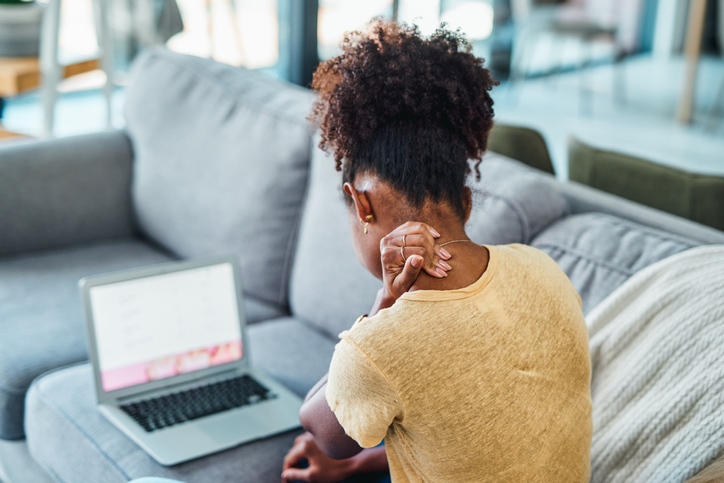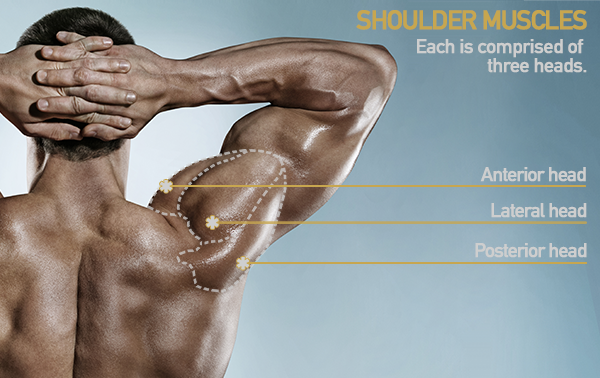Best Shoulder Stretches to Relieve Tension

Phones and laptops have done wonders for our workflow and communication.
But our shoulders? Not so much.
The amount of time most of us spend slumped over a screen or keyboard has led to a population that seems to be frozen mid-shrug.
That’s why it’s so important to include neck and shoulder stretches into your routine.
“Your muscles are incredibly efficient and will adapt to whatever position you have them in the most,” says Trevor Thieme, C.S.C.S. “That’s a problem if you have a desk job, which likely puts you in a hunched position for hours on end each day.”
What Causes Stiff Shoulders?
As you clock time in front of the computer screen, the muscles on the front of your body adapt to a shortened position, and those on the back of your body adapt to a lengthened position.
This chronic imbalance can cause your shoulders to feel stiff and tight whenever you try to move them through a full range of motion (like reaching for something on a high shelf or passing a toy to your kid in the back seat).
Intense exercise can also contribute to tight shoulders.
“When you challenge yourself during a workout — especially if that challenge comes from strength training — you cause micro-tears in your muscle tissue,” Thieme says. “That’s usually a good thing — it’s part of the remodeling process that results in bigger, stronger muscles. But it can also cause inflammation, which is often felt as stiffness and soreness.”
How Do You Get Rid of Tension in Your Shoulders?

Stretching your shoulders and the surrounding muscles — including your lats, traps, and pecs — can help reduce shoulder tension and ease discomfort.
This can help enhance mobility and unlock greater strength during upper-body and shoulder workouts.
Below, we explain how to do some of the best shoulder stretches from workouts on BODi.
Static vs. Dynamic Shoulder Stretches
There are two primary types of stretching (static and dynamic), and both can help increase flexibility (a muscle’s ability to stretch) and mobility (the degree to which you can move a joint through a complete range of motion).
But in order to maximize those benefits, you need to do the right kind of stretch at the right time.
Dynamic stretches are active and involve moving a muscle in and out of a stretched position.
Walking lunges, arm circles, and trunk rotations are all examples of dynamic stretches.
“Dynamic stretching increases blood flow and central nervous system activity, and it improves dynamic (or ‘active’) flexibility, which is the kind you need for every athletic endeavor,” Thieme says.
Static stretches, on the other hand, are just what their name implies: unmoving.
Anyone who attended a high school PE class is likely familiar with the reach-and-hold process of static stretching.
It’s especially good for improving flexibility, but because it relaxes muscles and decreases nervous system activity, it’s best to do these kinds of shoulder stretches after workouts.
9 of the Best Shoulder Stretches for Relieving Tension
Relieve tight shoulders with these stretches from BODi.
Before you crush that upper-body workout, prime your shoulders and boost blood flow with dynamic shoulder stretches (moves one and two).
Then — before you mix up a bottle of Beachbody Performance Recover post-workout shake — relax those muscles with static stretches (moves three to nine).
1. Behind-the-back band stretch
Appears in: The Master’s Hammer and Chisel – Hammer Conditioning
The back-and-forth movement of this dynamic shoulder stretch not only engages the rotator cuff, but it also helps ease tension in tight chest muscles.
- Grab a resistance band or roll up a towel length-wise, and grip an end in each hand.
- Hold the band or towel in front of you at waist height and pull your hands apart to create tension.
- Keeping your arms straight, raise the band or towel overhead and lower it behind you. The wider your hands, the easier that will be.
- Reverse the movement to return to the starting position, and repeat.
2. Egoscue
Appears in: 22 Minute Hard Corps – Special Ops Resistance
You just may break a sweat after 20 reps of this simple but effective dynamic shoulder stretching exercise.
- Stand tall with your feet hip-width apart and touch your knuckles to your temples with your elbows flared out to your sides. This is the starting position.
- Bring your elbows together in front of your face.
- Return to the starting position, and repeat.
3. Puppy
Appears in: Shift Shop – Mobility
This isn’t just ones of the best shoulder stretches yoga has to offer; it’s great for your upper body in general, as it eases tension in the shoulders, upper back, and chest.
- Start in a tabletop position on the ground with your hands below your shoulders and your knees below your hips.
- Keeping your hips lifted and arms straight, walk your hands forward until you can rest your forehead on the floor.
- Press your chest toward the floor and hold. You should feel the stretch in your shoulders, upper back, and chest.
4. Arm across the chest
Appears in: Brazil Butt Lift – Sculpt
This basic shoulder stretch can also be done from a seated position, making it an ideal one to perform throughout your workday. (Here are a few more stretches you can do sitting at your desk.)
- Stand with your feet slightly wider than hip-width apart and raise your arms laterally to shoulder height.
- Keep your right arm straight as you bring it across your chest and hook your left arm around it above your right elbow.
- Use your left arm to draw your right arm toward your chest. You should feel the stretch in your right shoulder.
- Hold for time, and then switch arms and repeat.
5. Chest opener
Appears in: Clean Week – Active Flex
This shoulder stretch also opens the chest, helping ease the tension built up from hours spent hunched over a keyboard.
Take a break from your computer and give this one a try.
- Stand with your feet hip-width apart, and interlace your fingers behind you.
- Roll your shoulders back and lift your chest up as you pull your hands back and down. Hold for time. You should feel the stretch in both your chest and shoulders.
6. Forward fold
Appears in: BODi Yoga Studio – Shoulder Care with Caley Alyssa
This stretch is a more advanced version of the chest opener.
It adds a forward fold to give you an even deeper shoulder stretch, while also stretching your hamstrings.
- Stand with your feet slightly wider than hip-width apart, bending your knees slightly.
- Interlace your fingers behind you and roll your shoulders back. Allow your elbows to bend.
- Keeping your back flat, hinge forward at your hips as far as you can. If you have the mobility, straighten your legs and lower your interlaced arms toward the floor.
- Hold, and then reverse the movement to return to the starting position.
7. Upper back stretch
Appears in: CORE DE FORCE – Active Recovery
This stretch is especially effective for those who hold tension in their shoulders and upper back.
- Stand with your feet slightly wider than hip-width apart.
- Keeping your elbows straight, raise your arms to shoulder height in front of you, rotating your wrists and pressing your palms together so that the back of your right hand faces left, and vice versa. This is the starting position.
- Press your arms forward, rounding your upper back slightly until you feel the stretch.
- Hold, and return to the starting position. Switch hand positions, and repeat.
8. Hip opener
Appears in: INSANITY – Max Recovery
The primary goal of this stretching exercise is to open your hips, but as you alternately press each leg apart, you’ll also stretch your shoulders, giving you two stretches in one move.
- Stand with your feet wider than hip-width apart and turned slightly outward.
- Keeping your back flat and core engaged, push your hips back and lower your body as far as you can into a sumo squat position, placing your hands on your knees.
- Straighten your right arm so that your right hand pushes against the inside of your right knee as you rotate your upper body to the left. You should feel the stretch in your right shoulder and inner thigh.
- Hold, and then repeat, this time straightening your left arm and rotating right.
9. Thread the needle
Appears in: The Master’s Hammer and Chisel – Chisel Endurance
Yogis know that the child’s pose is one of the most restorative stretches one can do, especially when it comes to reducing tightness in the hips, thighs, and ankles. This variation (known as thread the needle) also eases tension in the shoulders.
- Start in a tabletop position with your hands below your shoulders and your knees below your hips. The tops of your feet should be on the floor.
- Push your hips back and down until your glutes are on your heels, and then walk your hands forward until your forehead touches the floor. This position is known as child’s pose.
- Thread your right arm under your body to your left, pressing your right shoulder into the ground until you feel a stretch.
- Hold, and then return to child’s pose (both arms forward).
- Repeat with your left arm.
Shoulder Anatomy

Stretches for easing tight and stiff shoulders primarily target your deltoids and rotator cuffs. Here’s how these shoulder muscles control the movement and contribute to the mobility of your shoulders.
Deltoid
The deltoid is a triangular muscle located at top of the shoulder.
It’s divided into three sections (or “heads”) — anterior, middle, and posterior — and it serves several different functions, including lifting the arm to the front, side, and behind the body, and also rotating the arm toward and away from the body.
The heads originate at the clavicle, acromion, and scapular spine, and fuse together to attach to the humerus.
These shoulder stretches will also give you a great deltoid stretch.
Rotator Cuff
While often referred to as one muscle, the rotator cuff is actually made up of four smaller muscles: supraspinatus, infraspinatus, subscapularis, and teres minor.
All four originate at different parts of the scapula and attach to the humerus.
Collectively, these muscles provide stability to the shoulder joint. Separately, they have slightly different functions. The infraspinatus and teres minor help rotate the arm laterally.
The subscapularis is charged with medial rotation. And the supraspinatus assists the deltoid in arm abduction.
The Bottom Line
Try these shoulder stretches to relieve shoulder tension and if you’re ready for more, go to BODi to do the full programs!
